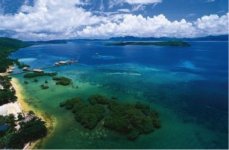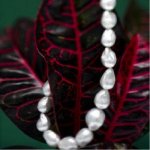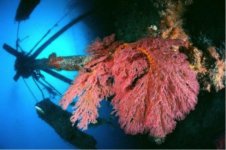One more link regarding Environmental issues and pearl farming.
This one comes from the website of Seabourn Pearls Freeport Maine, curiously enough it contain pictures from Paspaley (Australia) and Jewelmer (Philippines).
Pearls and the Environment

Palawan Pearl Farm. Photo: Jewelmer
Among gems the pearl stands alone in its kindly relationship to the environment. Pearls are produced inside living creatures and created in concert with the natural processes of the living earth. The growing popularity of pearls is due in part to their appeal amongst environmentally aware consumers committed to sustainable lifestyles.
Saltwater oysters are surprisingly fragile creatures that thrive in the most pristine growing conditions. Pearl farms are best suited for remote marine habitats far from populated areas. Most saltwater pearl farms are way off the grid and are, by necessity, highly sustainable operations that utilize the sun and wind for power and conserve resources carefully. Farmers understand the health of their crop is inextricably linked to the health of the environment. Pearl farmers are often leaders in their local environmental organizations. They promote and abide by strict environmental standards to insure the marine ecosystems upon which their livelihood depends remain clean and rich with plankton.
For their part, oysters are filter feeders and clean their host waters 24/7. The networks of floating cages that comprise a farm provide vital shelter and spawning areas for countless fish and sea life. Oyster stocks are carefully monitored and nurtured to comply with wild oyster quotas and to insure an adequate supply for cultivation. Indeed, if not for pearl farming most pearl producing oysters would be endangered or extinct.
In addition to pearls, pearl farms also harvest shells and meat. The shells are sold to craft industries to be used for mother-of-pearl inlays. Oysters that cannot be re-nucleated are cleaned and the meat is sold both fresh and canned as highly prized food products. Secondary products include dried meat for fertilizer and crushed shells for landscaping products. Nothing goes to waste.
The environmental impact of freshwater pearl production is more spotty but improving. The potential for profits coupled with the absence of government regulation, China’s vast network of lakes and rivers and unmatched labor resources resulted in a proliferation of pearl farms throughout China.
Many lakes and rivers are under stress from overproduction but the biggest environmental threat from freshwater pearling is the unregulated disposal of the byproducts used in processing. Too often pearls at harvest are treated beyond basic washing. They might be chemically treated to lighten color, dyed to create new colors, or shined using waxes or polishing compounds. These processes, and the handling of the waste associated with them, are not regulated.

Photo: Paspaley Pearls
But things are improving. With support from buyers, education programs have emerged to encourage farmers to make adjustments to their wastewater practices. Foreign brokers are making direct investments in Chinese pearl farms to insure the availability of quality product that meets the environmental standards of enlightened consumers. Seabourn Pearls only buys natural color, minimally processed pearls from farms that use sustainable practices. The Chinese are keen business people. Ultimately, when consumers stop buying dyed, color treated and over-processed pearls the Chinese will stop making them. Nature benefits when we buy natural products.
Processing problems aside, pearling in China provides important environmental benefits. Pearl farms are an abundant source of wetlands habitat for fish and migrating birds. Hundreds of thousands of recycled soda bottles have found new use as buoys for mussel cages. Agricultural byproducts from pig, chicken and soybean farms are recycled to grow plankton which in turn feeds the mussels. At harvest, after the pearls are separated, the meat is frozen for fish food or recycled into fertilizer and the shells are sold to craft factories.

Coral and Cages. Photo: Jewelmer
In the end, saltwater oysters dictate that pearl farmers engage in environmental stewardship or suffer the economic consequences of poor quality harvests. Freshwater pearling requires greater vigilance on the parts of farmers and consumers but still holds the promise of net environmental benefits. But compared to the blasting, open pit mining and heavy metals used to extract diamonds, colored gemstones and precious metals from earth, pearls are the gentlest gem. And there is no such thing as a “blood pearl.”
No matter what color or style you choose, rest assured your Seabourn Pearls are green.
Come see for yourself. Contact Seabourn Pearls today and schedule a private appointment to see our wondrous collection of gentle gems. Or browse our online gallery of beautiful pearls. If we can answer any pearl questions you may have call us directly at anytime. We love to share our knowledge and passion for pearls. As seen in Seabourn Pearls Freeport, Maine.



